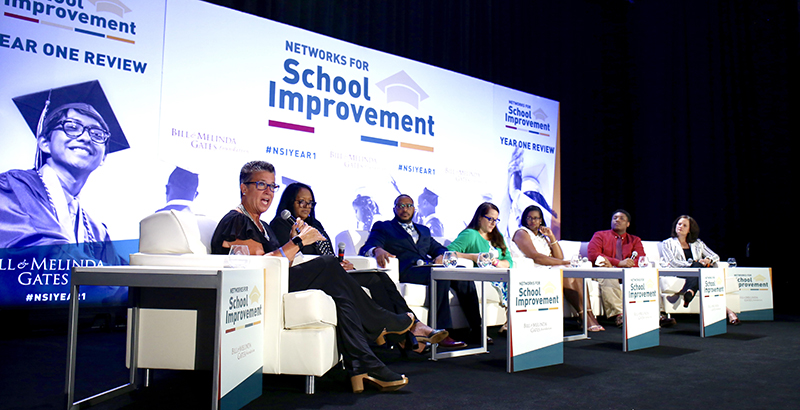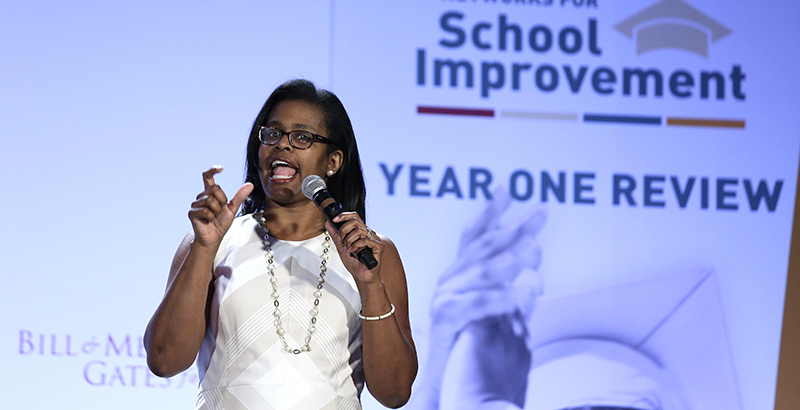Fixing Struggling Schools Is Hard. Moving Past Quick Fixes and Focusing on ‘Continuous Improvement’ Is Key, Gates Grantees Say

College Park, Maryland
As one of 21 recipients of a Bill & Melinda Gates Foundation grant to fund school improvement networks, Baltimore school officials had to first get over a desire for quick fixes.
“When we first came together, solution-itis set in,” and principals expected immediate actions they could take in their schools, said Janise Lane, executive director of teaching and learning in the district.
It took a while to break through skepticism of the Gates-endorsed “continuous improvement” model, one that demands a radical rethinking of how to improve outcomes for students in long-struggling schools, recipients of those grants said at a convening Tuesday.
The Gates Foundation last year announced $93 million in grants to 21 charters, nonprofits, universities and school districts that form networks of schools. All grantees work at the middle and high school levels on issues like completing key math and English courses or matching students with the right college, toward a broader goal of improving long-term results for low-income students and children of color.
The Tuesday event followed the release of a Gates Foundation paper that detailed early findings from grantees, including trouble finding the root causes of educational inequities, and learning how to use new data measures without being overwhelmed by available metrics.
Baltimore officials, who are using the grant to focus on middle and high school literacy, had to change ingrained habits formed during years in the school improvement trenches.
At the district level, top officials were unsure whether continuous improvement would help identify real problems, CEO Sonja Santelises said at a first-year review held at the University of Maryland.
But after a process that spanned two to three days, looking at both traditional data (like standardized test scores and literacy rates) and non-traditional data (like infant mortality and the size of parks), there was wider support.
The process is aimed at combing through data to arrive at discrete problems that can be addressed to aid the district’s broader goals — in Baltimore’s case, boosting middle and high school reading achievement. The technique allowed officials to identify the problem “based on real need, and we had built consensus around that,” Santelises said.

Unlike traditional district efforts, continuous improvement doesn’t require an immediate one-size-fits-all intervention — a challenge for school leaders.
The process has also been slow and deliberate at the school level, Baltimore officials said.
It took four or five meetings — more than expected — to identify specific problems to address at the school level, said Kamala Carnes, principal at Briscoe Academy.
The process also required school leaders and teachers to be open, and perhaps a little vulnerable, about their own weaknesses. “It was a lot of hard, hard work,” Carnes said. “It was times we were like, ‘OK, when are we going to figure out the problem?’”
It was “a series of stops and starts,” and school leaders ultimately changed their focus after looking at data and speaking with other schools in the network, said James Thurman, one of the city’s literacy coaches.
The day-long event had several panels and speakers representing other Gates grantees who offered recommendations to succeed in these interventions. Some highlights:
● Know the specific conditions in each district and school.
● Work to create data that can be used for school improvement.
● To combat political challenges at the local level, ensure that the superintendent and school board are supportive of the efforts.
● Make sure teachers and school leaders know they can fail at improvement efforts without penalty.
● Give teachers the authority to abandon interventions when they aren’t working.
Disclosure: The Bill & Melinda Gates Foundation provides financial support to The 74.
Get stories like these delivered straight to your inbox. Sign up for The 74 Newsletter

;)
